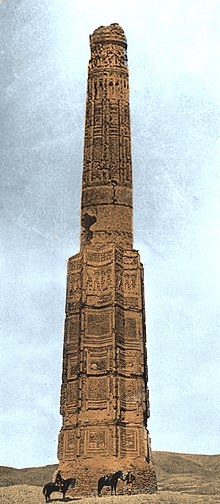Ghazni Minarets
Former elaborately decorated minaret towers located in Ghazni city, Afghanistan From Wikipedia, the free encyclopedia
The Ghazni Minarets are two elaborately decorated minaret towers located in Ghazni city, central Afghanistan. They were built in middle of the twelfth century and are the only surviving elements of the mosque of Bahram Shah.[3] The two minarets are 600 meters (1968 feet) apart and lie in an open plain, north-east of Ghazni city.[4]
 Mas'ud III's minaret was at least 44 meters tall, before its cylindrical top half crumbled following an earthquake in 1902. It was built between 1099 and 1115 CE (photographic reconstruction).[1] | |
| Alternative name | Mas'ud III Minaret & Bahram Shah Minaret[2] |
|---|---|
| Location | Ghazni, Afghanistan |
| Region | Ghazni Province |
| Coordinates | 33°33′52.4″N 68°26′01.8″E |
| Type | Minaret |
| Height | 20 m (66 ft) |
| History | |
| Builder | Masud III, Bahram-Shah of Ghazna |
| Material | Bricks |
| Founded | 12th century |
| Site notes | |
| Condition | Endangered |
The minarets had a height of 44 meters in the 19th century, before the top half of both minarets crumbled in an earthquake in 1902.[1] Now the minarets are about 20 meters high. Both minarets of Ghazni are 20 metres (66 feet)[5] tall and built of fired mud brick. The surface of the towers are decorated beautifully with intricate geometric patterns and Quranic verses on elaborate terracotta tiles. In the 1960s, both towers were fitted with sheet metal roofs in a limited preservation effort.[3][5]
The ruins of the Palace of Sultan Mas'ud III are located near Mas'ud III's minaret.
History
The 12th century minarets are the most famous monuments of Ghazni city and are among the last surviving remnants of the great Ghaznavid Empire. The two minarets are called, Mas'ud III Minaret (Manar-i Mas'ud III) and Bahram Shah Minaret (Manar-i Bahram Shah) after the ruler who built them, Mas'ud III (A.D. 1099–1115) and Bahram Shah (A.D. 1118–1157).[2] The excavated palace of Mas'ud III lies nearby to the towers.[4]

The minarets were taller before the upper sections were damaged and destroyed over time. Part of the Masud III minaret top was destroyed in an earthquake in 1902.[3][5]
Threats
Ghazni Minarets are not well preserved or protected. Both towers are in danger from natural elements and the political instability in Afghanistan. There are no basic security measures in place to prevent vandalism and the towers are in need of new roofing to prevent water infiltration into the towers.[5]
The towers' facade contains intricate geometric patterns and Quranic inscriptions which are deteriorating rapidly with exposure to rain and snow. They are further affected by the nearby road and the area is subject to periodic flooding.[5]
Gallery
Summarize
Perspective
Mas'ud III Minaret
Mas'ud III's minaret is stylistically more complex, and uses a larger variety of decorative techniques, compared to the minaret of his son Bahram Shah.[1]
- Mas'ud III's minaret, Ghazni, built between 1099 and 1115 CE. Photographed by Oscar von Niedermayer, 1916-1917
- Basis of Mas'ud III's minaret, with protective roofing (2010)
- Detail of the Intricate Brickwork on the Mas'ud III Tower
Bahram Shah Minaret
Minaret of Bahram-Shah
(before and after 1902)
(before and after 1902)
Bahram Shah minaret in 1839, with cylindrical top half.
Remaining basis of Bahram Shah's minaret in Ghazni, in 2011.
The minaret, inspired by the minaret of his father Mas'ud III, used to be more than 44 meters tall until the top half crumbled following an earthquake in 1902.[1]
Bahram Shah's minaret was inspired by the minaret of his father, and built a few decades later (he ruled between 1117 and 1152), but is stylistically simpler.[1]
- Bahram Shah minaret in 1839, with cylindrical top half (fallen in 1902).
- Bahram Shah's minaret as seen in 2001.
- Remaining basis of Bahram Shah's minaret in Ghazni.
- Bahram Shah Minaret (decorative detail)
See also
References
Wikiwand - on
Seamless Wikipedia browsing. On steroids.












